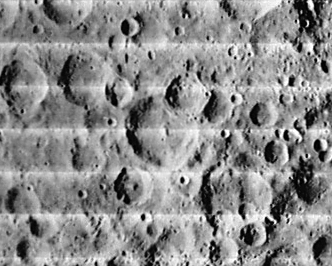Difference between revisions of "Chauvenet"
(Created page with "<div id="content_view" class="wiki" style="display: block"> =Chauvenet= {| class="wiki_table" | Lat: 11.5°S, Long: 137.0°E, Diam: 81 km, Depth: km, Rükl: ''(farside)''<b...") |
|||
| Line 10: | Line 10: | ||
[http://www.lpod.org/coppermine/thumbnails.php?album=search&type=full&search=Chauvenet LPOD Photo Gallery] [http://www.lpi.usra.edu/resources/lunar_orbiter/bin/srch_nam.shtml?Chauvenet%7C0 Lunar Orbiter Images] [http://www.lpi.usra.edu/resources/apollo/search/feature/?feature=Chauvenet Apollo Images]<br /> A pair of good eyes could detect '''Chauvenet''' in these three orbital photographs made during Apollo 8 in december 1968: [http://www.lpi.usra.edu/resources/apollo/frame/?AS08-12-2119 AS08-12-2119], [http://www.lpi.usra.edu/resources/apollo/frame/?AS08-12-2120 2120], and [http://www.lpi.usra.edu/resources/apollo/frame/?AS08-12-2121 2121]. The small bright crater in frames 2119 and 2120 is '''Chauvenet L''' (very distinct on LAC 84 of the ''Clementine Atlas''! <span class="membersnap">- [http://www.wikispaces.com/user/view/DannyCaes [[Image:DannyCaes-lg.jpg|16px|DannyCaes]]] [http://www.wikispaces.com/user/view/DannyCaes DannyCaes] <small>Oct 20, 2012</small></span>).<br /> Detection of '''Chauvenet''' in these three Apollo 8 frames: David Woods and colleagues ([http://history.nasa.gov/ap08fj/photo12-d.htm Apollo 8 Flight Journal]).<br /> <br /> <br /> | [http://www.lpod.org/coppermine/thumbnails.php?album=search&type=full&search=Chauvenet LPOD Photo Gallery] [http://www.lpi.usra.edu/resources/lunar_orbiter/bin/srch_nam.shtml?Chauvenet%7C0 Lunar Orbiter Images] [http://www.lpi.usra.edu/resources/apollo/search/feature/?feature=Chauvenet Apollo Images]<br /> A pair of good eyes could detect '''Chauvenet''' in these three orbital photographs made during Apollo 8 in december 1968: [http://www.lpi.usra.edu/resources/apollo/frame/?AS08-12-2119 AS08-12-2119], [http://www.lpi.usra.edu/resources/apollo/frame/?AS08-12-2120 2120], and [http://www.lpi.usra.edu/resources/apollo/frame/?AS08-12-2121 2121]. The small bright crater in frames 2119 and 2120 is '''Chauvenet L''' (very distinct on LAC 84 of the ''Clementine Atlas''! <span class="membersnap">- [http://www.wikispaces.com/user/view/DannyCaes [[Image:DannyCaes-lg.jpg|16px|DannyCaes]]] [http://www.wikispaces.com/user/view/DannyCaes DannyCaes] <small>Oct 20, 2012</small></span>).<br /> Detection of '''Chauvenet''' in these three Apollo 8 frames: David Woods and colleagues ([http://history.nasa.gov/ap08fj/photo12-d.htm Apollo 8 Flight Journal]).<br /> <br /> <br /> | ||
==Maps== | ==Maps== | ||
| − | ''([http://the-moon. | + | ''([http://the-moon.us/wiki/LAC%20zone LAC zone] 84D2)'' [http://planetarynames.wr.usgs.gov/images/Lunar/lac_84.pdf USGS Digital Atlas PDF]<br /> <br /> |
==Description== | ==Description== | ||
<br /> | <br /> | ||
| Line 19: | Line 19: | ||
==Nomenclature== | ==Nomenclature== | ||
* Named for [http://en.wikipedia.org/wiki/William_Chauvenet William Chauvenet] (1820 – 1870), an early American educator. A professor of mathematics, astronomy, navigation, and surveying, he was always known and well-liked among students and faculty. He was instrumental in the founding of the United States Naval Academy at Annapolis, Maryland. | * Named for [http://en.wikipedia.org/wiki/William_Chauvenet William Chauvenet] (1820 – 1870), an early American educator. A professor of mathematics, astronomy, navigation, and surveying, he was always known and well-liked among students and faculty. He was instrumental in the founding of the United States Naval Academy at Annapolis, Maryland. | ||
| − | * '''Saha''' was among the long list of farside names approved by the IAU in 1970 and published in [http://the-moon. | + | * '''Saha''' was among the long list of farside names approved by the IAU in 1970 and published in [http://the-moon.us/wiki/Chauvenet%2C%201971 Chauvenet, 1971]. |
| − | * In the planning for Apollo 8, the first manned circumlunar mission (1968), this crater (which did not then have an official name) was referred to informally as "'''Slayton'''" (source: [http:// | + | * In the planning for Apollo 8, the first manned circumlunar mission (1968), this crater (which did not then have an official name) was referred to informally as "'''Slayton'''" (source: [http://www2.lpod.org/wiki/September_9,_2007 Phil Stooke's LPOD]). |
* A crater west of '''Chauvenet''' is called '''''Corneille''''' on LTO 84-D4. Who was Corneille? See this [http://en.wikipedia.org/wiki/Pierre_Corneille Wikipedia-page]. | * A crater west of '''Chauvenet''' is called '''''Corneille''''' on LTO 84-D4. Who was Corneille? See this [http://en.wikipedia.org/wiki/Pierre_Corneille Wikipedia-page]. | ||
<br /> | <br /> | ||
Revision as of 19:11, 11 April 2018
Contents
Chauvenet
| Lat: 11.5°S, Long: 137.0°E, Diam: 81 km, Depth: km, Rükl: (farside) |
Table of Contents
[#Chauvenet Chauvenet]
[#Chauvenet-Images Images]
[#Chauvenet-Maps Maps]
[#Chauvenet-Description Description]
[#Chauvenet-Description: Wikipedia Description: Wikipedia]
[#Chauvenet-Additional Information Additional Information]
[#Chauvenet-Nomenclature Nomenclature]
[#Chauvenet-LPOD Articles LPOD Articles]
[#Chauvenet-Bibliography Bibliography]


left: LOI-115-M . right: LROC . Chauvenet at center, with satellite C protruding over north east (upper right) rim.
Images
LPOD Photo Gallery Lunar Orbiter Images Apollo Images
A pair of good eyes could detect Chauvenet in these three orbital photographs made during Apollo 8 in december 1968: AS08-12-2119, 2120, and 2121. The small bright crater in frames 2119 and 2120 is Chauvenet L (very distinct on LAC 84 of the Clementine Atlas! - DannyCaes DannyCaes Oct 20, 2012).
Detection of Chauvenet in these three Apollo 8 frames: David Woods and colleagues (Apollo 8 Flight Journal).
Maps
(LAC zone 84D2) USGS Digital Atlas PDF
Description
Description: Wikipedia
Additional Information
Nomenclature
- Named for William Chauvenet (1820 – 1870), an early American educator. A professor of mathematics, astronomy, navigation, and surveying, he was always known and well-liked among students and faculty. He was instrumental in the founding of the United States Naval Academy at Annapolis, Maryland.
- Saha was among the long list of farside names approved by the IAU in 1970 and published in Chauvenet, 1971.
- In the planning for Apollo 8, the first manned circumlunar mission (1968), this crater (which did not then have an official name) was referred to informally as "Slayton" (source: Phil Stooke's LPOD).
- A crater west of Chauvenet is called Corneille on LTO 84-D4. Who was Corneille? See this Wikipedia-page.
LPOD Articles
Bibliography
APOLLO OVER THE MOON; A VIEW FROM ORBIT, Chapter 3: The Terrae (Part 1), Figure 33.
This page has been edited 1 times. The last modification was made by - tychocrater tychocrater on Jun 13, 2009 3:24 pm - afx3u2